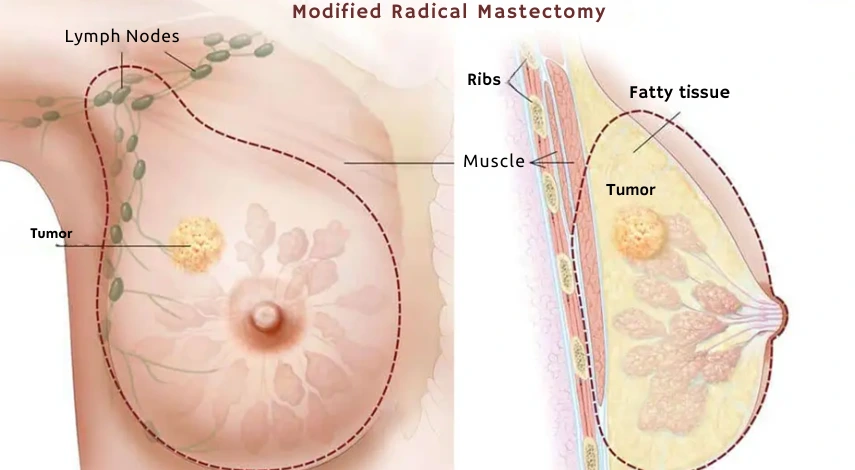Mastectomy is a surgical procedure involving the complete removal of the breast, performed for oncologic purposes, most commonly in cases of breast cancer.
When Is Mastectomy Indicated?
- When breast-conserving procedures (such as sectorectomy) are not feasible;
- At the informed request of the patient, who may prefer mastectomy over conservation surgery, which typically requires adjuvant radiotherapy and long-term monitoring;
- In patients with a significantly elevated oncologic risk, such as those carrying BRCA1 or BRCA2 gene mutations. Find out which tests are used by doctors to identify breast cancer. Remember, screening tests are performed to be able to detect cancer before the patient shows symptoms;
- When the tumor is large relative to the size of the breast, making preservation technically or oncologically unsuitable.
How Many Types of Mastectomies Are There?
- Modified Radical Mastectomy – involves removal of the mammary gland, overlying skin, and axillary lymph nodes.
- Subtotal (Skin-Sparing) Mastectomy – preserves most of the breast skin envelope, facilitating immediate or delayed reconstruction.
- Nipple-Sparing Mastectomy – preserves the nipple-areolar complex, often selected for immediate breast reconstruction using autologous or implant-based techniques.
- Bilateral Prophylactic Mastectomy – indicated in high-risk patients (e.g., BRCA1/2 carriers), typically performed without axillary dissection and with preservation of the nipple and areola.

How Is the Mastectomy Performed?
A preoperative consultation with both the surgeon and anesthesiologist is essential. During this appointment, the surgical rationale, anesthesia type, risks, and postoperative course will be thoroughly explained.
The discussion should also include options for breast reconstruction, which may occur during the same surgical session or be delayed. Options include:
- Placement of saline or silicone implants;
- Use of musculocutaneous flaps, such as latissimus dorsi or TRAM flaps;
- A hybrid approach combining both implant and autologous tissue techniques.
Preoperative Preparation for Mastectomy
The surgical team will provide specific instructions prior to the procedure, including:
- Discontinuation of medications that interfere with clotting, such as NSAIDs or anticoagulants;
- Fasting from liquids and solids for 8–12 hours before surgery to minimize anesthesia-related risks;
- Planning for a hospital stay of approximately 2 to 3 days, depending on the case.
How the Mastectomy Operation Is Performed
During surgery, one or two drainage tubes are typically placed at the operative site, connected to external collection devices. These remain in place for 10 to 14 days to prevent fluid accumulation.
Following the procedure, the patient is transferred to a monitored recovery or intensive care setting for cardiopulmonary observation.
Mastectomy operation explained step by step
Discharge After Mastectomy Surgery
Patients are generally discharged 2 to 3 days postoperatively, with thorough instructions on:
- Wound care: including antiseptic application, frequency of dressing changes, and drain management;
- Medications: such as analgesics, anti-inflammatory agents, and prophylactic anticoagulants;
- Physical activity: recommendations for post-mastectomy exercises and progression of movement;
- Personal hygiene: including guidance on when and how to resume showering;
- Prosthetics and support garments: including timing for wearing bras or external breast prostheses.
What Is the Treatment After Mastectomy?
Once the histopathology results are available (usually within 1 to 2 weeks), a multidisciplinary oncology team evaluates the findings to determine the need for further treatment.
Based on the tumor’s stage and biological profile, adjuvant therapy may include:
- Chemotherapy;
- Radiotherapy;
- Hormonal therapy.
These treatments are individualized and aimed at reducing recurrence and preventing metastasis.











